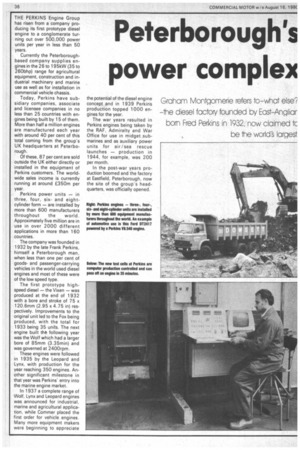Peterborough's power complex
Page 38

Page 39

If you've noticed an error in this article please click here to report it so we can fix it.
THE PERKINS Engine Group has risen from a company producing its first prototype diesel engine to a conglomerate turning out over 500,000 power units per year in less than 50 years.
Currently the Peterboroughbased company supplies engines in the 26 to 195kW (35 to 260bhp) range for agricultural equipment, construction and industrial machinery and marine use as well as for installation in commercial vehicle chassis.
Today, Perkins have subsidiary companies, associate and licensee companies in no less than 25 countries with engines being built by 15 of them.
More than half a million engines are manufactured each year with around 40 per cent of this total coming from the group's UK headquarters at Peterborough.
Of these, 87 per cent are sold outside the UK either directly or installed in the equipment of Perkins customers. The worldwide sales income is currently running at around 050m per year.
Perkins power units — in three, four, sixand eight cylinder form — are installed by more than 600 manufacturers throughout the world.
Approximately five million are in use in over 2000 different applications in more than 160 countries.
The company was founded in 1932 by the late Frank Perkins, himself a Peterborough man, when less than one per cent of goodsand passenger-carrying vehicles in the world used diesel engines and most of these were of the low speed type.
The first prototype highspeed diesel — the Vixen — was produced at the end of 1932 with a bore and stroke of 75 x 120.6mm (2.95 x 4.75 in) res pectively. Improvements to the original unit led to the Fox being produced, with the total for 1933 being 35 units. The next engine built /lit following year was the Wolf which had a larger bore of 85mm (3.35min) and was governed at 2400rpm.
These engines were followed in 1935 by the Leopard and Lynx, with production for the year reaching 350 engines. Another significant milestone in that year was Perkins' entry into the marine engine market.
In 1937 a complete range of Wolf, Lynx and Leopard engines was announced for industrial,
marine and agricultural application, while Commer placed the
first order for vehicle engines. Many more equipment makers were beginning to appreciate the potential of the diesel engine concept and in 1939 Perkins production topped 1000 engines for the year.
The war years resulted in Perkins engines being taken by the RAF, Admiralty and War Office for use in midget submarines and as auxiliary power units for air/sea rescue launches — production in 1944, for example, was 200 per month.
In the post-war years production boomed and the factory at Eastfield, Peterborough, now the site of the group's headquarters, was officially opened. Perkins launched subsidiary companies in Australia jn 1951 and in North America and France the following year. The company's worldwide manufacturing operations progressed with engines being built under licence in India and Yugoslavia In the ensuing years Perkins became a major supplier to many leading manufacturers, one of whom was a maker of agricultural machinery based in Canada by the name of MasseyFerguson.
In 1959 Perkins was acquired by Massey-Ferguson Ltd and today is still a wholly owned subsidiary of the corporation to whom it sells 35 per cent of its production for installation in agricultural, industrial and con struction machinery. Perkins sells the remaining 65 per cent of its production to "'thirdparty"' customers.
Further landmarks came in 1971 when worldwide sales topped £100m for the first time, with a total engine production of 345,000 engines and in 1975 when yearly engine production passed the half million mark. The Perkins Peterborough factory covers an area of over 235,000sqm (21/4m sqft) and is claimed by the company to be the largest diesel engine production centre in the world. It is also the main centre for research and development.
To be successful in the power-unit industry it is necessary to spend a great deal of money on research and development to stay ahead of the game. Perkins has put in a lot of investment in recent years with more than £40m being spent in the latter half of the Seventies on extending plant capacity and utilising modern technology.
In 1976 a new £.4.2m research engine test department with 110 test beds went into operation. Still on the engine test side, but this time referring to the testing of production engines, the latest Perkins investment is E2m out of a programme likely to cost £.17m.
The first stage of 26 cells can each check out 13 engines per shift compared with five for the older type of test bed. Ultimately there will be 210 of the new test cells which, because of their improved throughput, wili replace the present 305 beds.
The current range of Perkins engines for the automotive mar ket spans the 40 to 190kW (55 to 255bhp) sector. The bottom of the range is represented by the 4.108 engine which was designed as a direct replacement for the petrol engine in light goods and passenger vehicles.
Probably the best-known of the Perkins products is the 354
engine now produced in -dot fourform as the naturally aspirated 6.354.4 and the turb
ocharged T6.354.4. The Per kins type numbers denote the number of cylinders and the en gine capacity in cubic inches. Thus the 6.354 is a six-cylinder unit with a capacity of 354cuin (or 5.8 litres).
At the top end, the V8.640 series gives Perkins a contender in the 32-ton category. In turb ocharged form it develops 190kW 255bhp) at 2600rprn while the naturally aspirated equivalent produces 160kVV (215bhp).












































































































